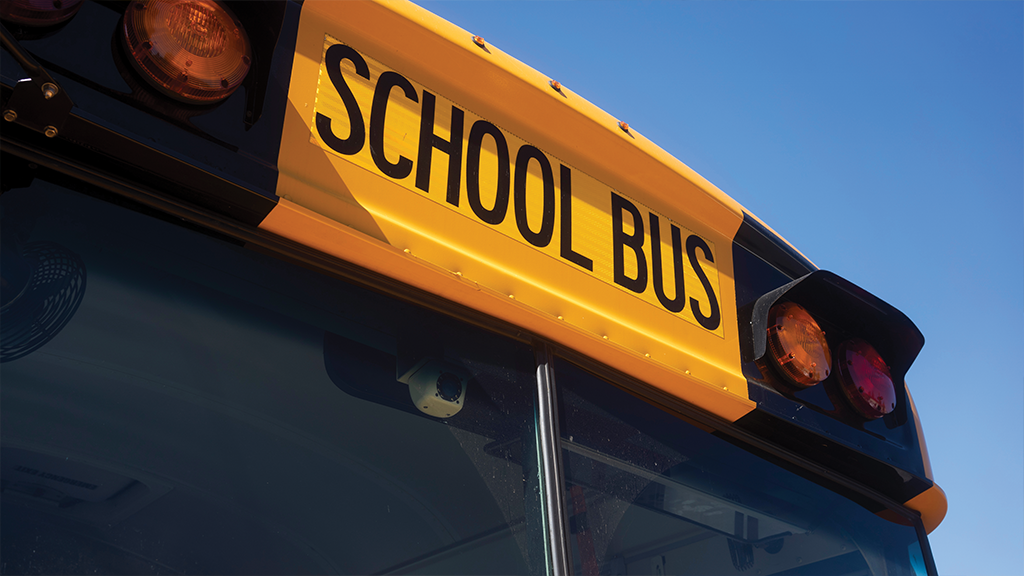
FIZKES/STOCK.ADOBE.COM
For over a century, the iconic yellow school bus and its predecessors have played a transformational role in making education accessible for millions of children who have no other way to get to school. And while the technology has evolved over the years—we have come a long way since the days of horse-drawn “school wagons”—that access mission remains just as salient today.
Now, the school bus is entering a new era, as districts nationwide begin swapping out their diesel-burning fleets for clean electric school buses. This transition holds vast potential for healthier school communities, but it also raises a new and critical set of questions about accessibility and equity. This is where district and state leaders come in, to help guide this transformation with an equity-
focused lens.
Interest in electric school buses is at unprecedented levels. As part of the Bipartisan Infrastructure Law, the Environmental Protection Agency (EPA) launched its new $5 billion Clean School Bus Program by providing nearly $1 billion in rebates to help with the purchase of electric school buses in every state. This funding was twice the level of what was initially planned, in response to applications totaling $4 billion. Over 90% of applications were for electric school buses.
The demand is well-justified.
Electric school buses have no tailpipe emissions, which means they offer the cleanest and healthiest school bus ride available—without emitting harmful pollutants linked to cancer, asthma, and other physical and cognitive development impacts. After the initial cost of purchase, they can save districts an average of $6,000 per bus per year in operational expenditures compared to diesel school buses, depending on local circumstances. They produce the lowest level of greenhouse gas emissions of any school bus type. Finally, and perhaps most fundamentally, they show our students and communities—nearly 20 million school bus riders and their families—that a different and more sustainable future is possible.
The benefits of electric school buses are many, but they must be realized by all our children and in all our communities. The transition to electric must be carried out with an intentional equity-oriented approach, or we run the risk of reinforcing ingrained systems of inequality and perpetuating longstanding environmental injustices.
Approximately 90% of U.S. school buses today run on diesel fuel, and while diesel exhaust is dangerous for everyone, its impacts are not felt equally. Racist lending, transportation, housing, and zoning policies mean that Black and Brown communities are often located closer to highways and other pollution sources. As a result, communities of color face on-road fine particulate matter pollution that is 61% to 75% higher than for white residents. Zooming in on student transportation, 60% of low-income students ride the bus to school, compared to 45% of non-low-income students. Students from Black households also are more likely to ride the bus to school and be exposed to diesel exhaust pollution than other peer groups, as are children with disabilities. Indeed, too many children, and especially children from underserved communities, miss school each year due to asthma, which is triggered and exacerbated by diesel exhaust pollutants.
Given these conditions, the transition away from diesel school buses to electric school buses must be equitable, ensuring that the communities most impacted by diesel exhaust pollution are at the front of the line for electric school buses—and that they’re meaningfully engaged and empowered throughout the process.
School leaders have an instrumental role to play. School bus electrification can be a tangible and high-impact strategy in your state and district’s agenda to address inequities. Here are three ways to get started:
- Learn more about the benefits of electric school buses and the process for bringing them to your district. The U.S. Department of Energy (https://afdc.energy.gov/vehicles/electric_school_buses.html) offers a variety of resources. Likewise, my organization, the World Resources Institute, has launched an Electric School Bus Initiative (https://electricschoolbusinitiative.org) where you can learn about the benefits of electrification, why the transition must center equity and issued a paper on why the transition must center equity (https://www.wri.org/insights/electric-school-buses-equity-us), and what we are doing to advance that equity agenda.
- Discuss equitable transportation electrification with your colleagues. Create space, both informally and on official agendas, to discuss the potential for your district to transition to electric buses. What resources are required? How can the adoption of electric buses address long-standing inequities within your community? Students, drivers, mechanics, and communities located near bus yards are some of the groups with a stake in this transition and expertise to contribute. Decisions about which depots and routes to electrify first and how to best prepare staff for this transition will be well-informed by their information. Reaching out to local environmental justice and equity organizations is another important step. Many, including the members of the Alliance for Electric School Buses (https://electricschoolbuses4kids.org), are deeply engaged in this work.
- Explore the EPA’s Clean School Bus Program and other funding. Over the next four years, the EPA will be awarding billions of dollars for this transition, and states and utilities (https://electricschoolbusinitiative.org/clearinghouse-electric-school-bus-funding-and-financing-opportunities) are following suit. Some of these programs are designed to support under-resourced communities, though much more remains to be done in the realm of equitable funding and financing.
As part of a district’s equity efforts, electric school buses can help ensure all young people, starting with those most impacted by pollution, have a safe and healthy ride to school, arriving ready to learn.
Carla Walker (Carla.Walker@wri.org) is the director of environmental justice and equity at the World Resources Institute.

Share this content